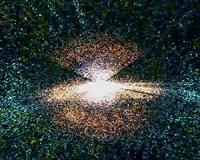 |
Sydney, Australia (SPX) May 02, 2011 What's in the night sky this week? Glad you asked! There's plenty but first, armed with your binoculars, find a nice dark place away from the glare of the street lights. Pick a comfy spot and wait about 5-10 minutes to allow your eyes to adapt to the darkness. See that band of stars stretching across the sky from one side to the other? That's the Milky Way, full of more stars than you can count. Search along the Milky Way with your binoculars and watch for 'fuzzy' patches. Stop and have a look, you might have found a rich star cluster or a gassy nebula. While you're at it look a little to the right of the Southern Cross. It's a rich area for sky spotting or panning so move slowly OK. Rising in the East after sunset is beautiful Saturn with its rings starting to open. Amazing in any size telescope, look for a yellowish 'star' about halfway above the horizon. In the morning, before sunrise that bright 'star' you can see above the Eastern horizon is really the planet Venus, commonly called the 'morning star.' Heard of it? Through a telescope Venus will show you phases, just like the Moon, and you'll notice it appears fuzzy. Well, that's about as good as it gets. Thankfully, there's nothing wrong with your telescope. Now, get set for a rare event because your view of the pre dawn sky from May 1st onwards should be spectacular. It's an alignment of the planets, astronomers call them conjunctions and they don't happen all that often! The four well known planets Mercury, Venus, Mars and giant Jupiter are all going to be in the same part of the eastern morning sky together, joined for a short time by a thin Crescent Moon. They're best observed from around an hour or so before sunrise until the sky starts to brighten and will all be closest on May 12th. Very close conjunctions are just a grand naked eye spectacle and great to try and photograph. Bracket your shots though and use a tripod. It can be very exciting to see more than one planet in the same field of view of your telescope. Good luck! Get David's free astronomy newsletter at www.davidreneke.com David Reneke is one of Australia's leading astronomers, lecturers and teachers. He's a feature writer for Australasian Science magazine and a science correspondent for ABC and commercial radio.
Share This Article With Planet Earth
Related Links - Astronomy News from Skynightly.com
 Measuring the distant universe in 3-D
Measuring the distant universe in 3-DBerkeley CA (SPX) May 02, 2011 The biggest 3-D map of the distant universe ever made, using light from 14,000 quasars - supermassive black holes at the centers of galaxies billions of light years away - has been constructed by scientists with the third Sloan Digital Sky Survey (SDSS-III). The map is the first major result from the Baryon Oscillation Spectroscopic Survey (BOSS), SDSS-III's largest survey, whose principal ... read more |
|
| The content herein, unless otherwise known to be public domain, are Copyright 1995-2010 - SpaceDaily. AFP and UPI Wire Stories are copyright Agence France-Presse and United Press International. ESA Portal Reports are copyright European Space Agency. All NASA sourced material is public domain. Additional copyrights may apply in whole or part to other bona fide parties. Advertising does not imply endorsement,agreement or approval of any opinions, statements or information provided by SpaceDaily on any Web page published or hosted by SpaceDaily. Privacy Statement |